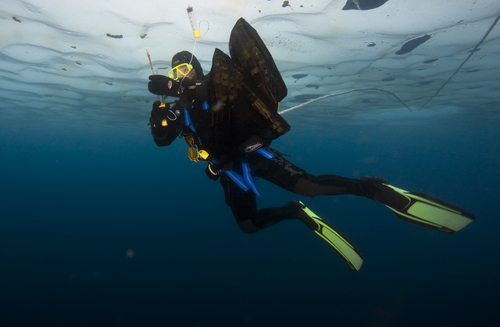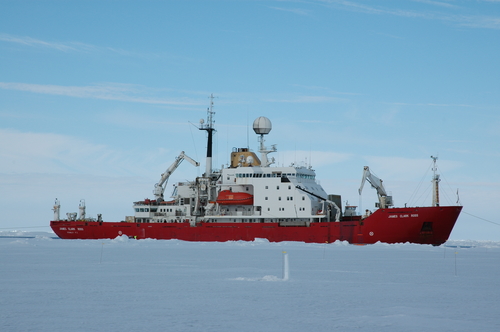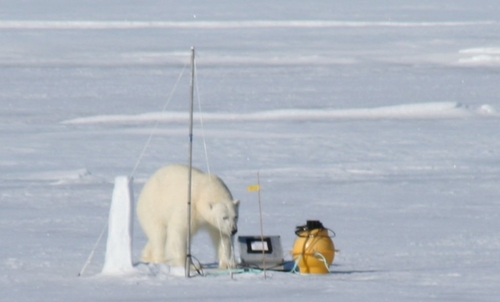Scientists from the Greenland Climate Research Centre have just returned from a field campaign on an ice floe north of Svalbard and Greenland Published 03.07.2010

Most of the ice leaving the Arctic Ocean is exported through the Fram Strait between Svalbard and Greenland, where it melts slowly on its way south. There are still many open questions as to how sea ice affects climate and ocean circulation. About 25 researchers from England, Germany, Spain, Denmark, Canada, Sweden, France and Greenland joined forces on the British research vessel James Clark Ross to answer some of them.
Scientists from the Greenland Climate Research Centre focused on the role of sea ice in gas exchange between ocean and atmosphere. They collected sea ice cores to investigate how calcium carbonate crystals dissolve in sea ice as it melts on its way south. Calcium carbonate crystals form in the sea ice in winter. During this formation, carbon dioxide gas forms and dissolves in the dense cold brine and a large fraction is rejected from the ice and sinks deeper into the ocean. It is believed that calcium carbonate crystals remain in the sea ice because they cannot move freely like carbon dioxide, oxygen and nitrogen gases. During summer, when sea ice melts and drifts southward, calcium carbonates dissolve and thus affect the surface-water carbonate balance. This freezing and melting of sea ice acts as a kind of pump causing carbon dioxide to be pumped into the deep in winter, while calcium carbonate crystals disintegrate in summer when sea ice melts. Ions released through this process affect the pH balance in the sea, which results in the entire area acting as a sink for atmospheric carbon dioxide. Evidence suggests that Polar Regions have a record high uptake of carbon dioxide gas from the atmosphere. Many questions still remain, however. Are crystals formed in the entire sea ice, or only on the surface? How many are dissolved in sea ice? Do some of them sink into the ocean and if so, how far down? These questions need to be answered if we are to understand how the Arctic affects the climate.
To investigate oxygen dynamics in melting sea ice, the climate centre team used three newly developed underwater systems (Eddy correlation) to measure directly the oxygen flux between sea ice and ocean. Compared with parallel gas flux measurements between atmosphere and sea ice, scientists can gain a detailed understanding of how gases are transported between atmosphere and sea ice and between sea ice and ocean. Underwater Eddy systems were installed at various distances from the ice to resolve spatial and temporal dynamics of gas fluxes. We also collected numerous samples to measure ice algal photosynthesis and bacterial respiration to quantify the biological contribution to gas exchange.
Throughout the campaign, robot-like machines moved up and down in the sea to collect detailed information on ocean currents, temperature, salt, gas content, the amount of microscopic algae, particles, etc. In addition, divers collected samples of sea ice and photographed and filmed the sea ice from below. This provided the team with the distribution of algae colonies under the ice. The weather was excellent. The ice floe to which James Clark Ross was anchored drifted rapidly south in a circular motion but remained intact during the entire campaign although it did become markedly thinner and warmer day by day. The scientists were visited frequently by polar bears – often several each day. In order to be able to retrieve divers from below the ice and researchers from the ice surface, it was necessary to keep a constant bear watch. Almost around the clock, scientists and crew took turns spending half-hour shifts scanning the horizon with binoculars from the upper deck.

The English research vessel “James Clark Ross” anchored at an ice floe in Fram Strædet. Photo: Søren Rysgaard

One of many polar bear visits. Photo: Hugh Brown

